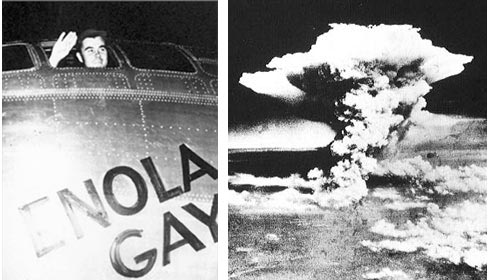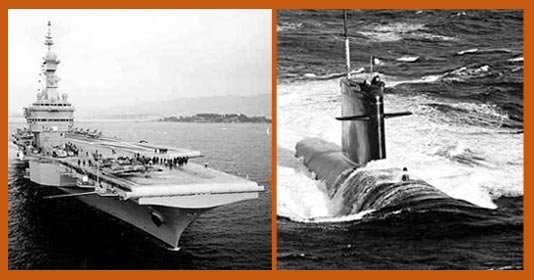The black face of the god Janus
The first scientists to examine the inner workings of the atom have since had responsibility for Hiroshima and Nagasaki thrust upon their shoulders. Without Rutherford’s discovery of the nucleus, Chadwick’s discovery of the neutron or Otto Hahn’s splitting of the uranium nucleus in 1938, we tend to believe that no atomic bombs could have been developed.
These conclusions, of course, ignore the fact that neutrons, nuclei and uranium all exist in nature and that fission is a phenomenon that science would have observed; if not in 1938, then at some point since then. It is also easy to forget that the decision to drop the bombs on two Japanese cities was made by those placed much higher up the chain of command than any physicist or engineer. These devastating weapons were bound to be developed someday, and the temptation to use them in times of war was sure to prove irresistible.

The Hiroshima bomb
Paul Tibbets, the pilot of the ENOLA GAY (the plane that dropped the first atomic bomb on Hiroshima on the 6th of August 1945) has never express regrets. He has always been convinced that the bomb was responsible for saving American lives, and eventually Japanese ones, by removing the necessity for an invasion of Japan.
© U.S. Army photo/ courtesy of the Hiroshima Peace Culture Foundation.
Our purpose here, however, is not to dwell on those tragic events which have defined the previous century. Everything has doubtless been said on the matter, and it would be overstepping our brief to write any more. The discussion of Nagasaki on these pages will be limited to the presentation of a testimony previously unseen in Europe.
Our focus will instead be on the consequences nuclear weaponry may have on the civilian population; the prevailing issue six decades after the end of the Second World War. Even during fifty years of fierce ideological conflict, Damocles’ atomic bomb never fell, though there was the occasional close call. Today, though the large number of non-proliferation treaties and monitoring bodies may not have removed the threat, they have at least brought it to the forefront of the world’s attention.

Aircraft carriers and nuclear submarines
Embarked nuclear reactors are used for the propulsion of submarines, aircraft carriers and ice breakers, thereby guaranteeing their ability to travel alone. Their fuel is highly enriched in fissile uranium or plutonium. These vessels can go for years without needing to stock up on fuel, as their compact on-board reactors can generate immense amounts of power. In France, the Navy’s depleted fuel undergoes reprocessing in a special section of the La Hague facility.
© CEA/DAM
The radioactive aftermath of the nuclear weapon tests conducted in the 1960’s by the United States, the USSR and other nuclear powers have caused comparatively little damage. The military nuclear industry as a whole, which includes the reactors found in aircraft carriers and submarines, produces radioactive waste of a very similar nature to that generated by nuclear power plants.
President Dwight Eisenhower, arguably the least warlike of WWII generals, is responsible for having set up the Atoms for Peace initiative in 1953 in an attempt to harness nuclear energy for peaceful means. Today, the number of countries with the technical capability to follow in America’s footsteps remains small, though countries such as Iran are eager to try.

Plutonium bunkers
Weapons-grade uranium and plutonium, used in the manufacture of atomic bombs, are an important part of the military’s nuclear industry. These highly sensitive substances are protected in high-security storehouses, such as these bunkers in the United States. The round-the-clock surveillance such bunkers require is very costly; certainly a motivating factor in the joint Russian and American decision to reduce their respective nuclear arsenals.
© DOE
The future of the nuclear energy industry is inextricably linked with the problem of proliferation, as industrial grade uranium and plutonium, in the wrong hands, can be purified for use in the manufacture of weaponry. Such purification techniques are fortunately very complex, and few countries are able to carry them out. The international non-proliferation treaties have done a lot to prevent the undesirable exporting of this technology, but both the treaties and their control systems need to be improved.
Last but not least are the massive nuclear stockpiles inherited from our Cold War days. Though the United States and Russia have both agreed to destroy what they define as ‘surplus’, the proposed reduction is by no means large enough. It has also been decided that the uranium and plutonium stockpiles of both countries should be reconverted for use in the energy industry; the simpler process for uranium has already begun, while the steps towards the recycling of plutonium were scheduled for 2007.
All these steps are good, but not good enough. Though admission to the nuclear club may be getting harder, the current members are the first to turn a deaf ear to the requests of the non-proliferation experts and to ignore the relevant treaties. In the United States, for instance, senior Pentagon officials have already announced their intention of developing new weapons technology.
Articles on the subject « Military Applications »
Nuclear Weapons
Atomic and thermonuclear bombs There are two types of nuclear bombs: the atomic A bombs and the t[...]
The 1945 A-bombs
Little Boy and Fatman The United States had available three bombs in July 1945: two made of pluto[...]
The Franck Report
The Scientists who opposed dropping atomic bombs on Japan In June 1945, shortly before the atomic[...]
Nagasaki
A Japanese account of the Nagasaki bomb Atomic bomb, rescue and relief report, a poignant small b[...]
Nagasaki First Aid
Extracts from Doctor Takashi Nagai first report In this first rescue report intended for the auth[...]
Atoms for Peace
1953: Eisenhower’s initiative for peaceful use of the atom After the Second World War, The [...]
Testing Nuclear Weapons
A practice that culminates in the 1950’s and 1960’s… The nuclear tests conducted by the sup[...]
Atomic Tests Fallout
An embarrassing legacy but alleviated with time Radioactive fallout differ significantly accordin[...]
Arsenals reduction
A modest step towards a reduction in nuclear arsenals During the Cold War, the United States and [...]